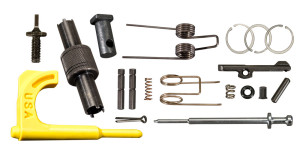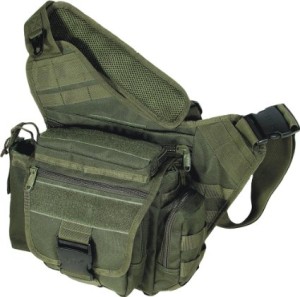 Integrated logistics support (ILS) is an integrated and iterative process for developing materiel and a support strategy that optimizes functional support, leverages existing resources, and guides the system engineering process to quantify and lower life cycle cost and decrease the logistics footprint (demand for logistics), making the system easier to support. Although originally developed for military purposes, it is also widely used in commercial product support or customer service organizations. – Source: http://en.wikipedia.org/wiki/Integrated_Logistics_Support
Integrated logistics support (ILS) is an integrated and iterative process for developing materiel and a support strategy that optimizes functional support, leverages existing resources, and guides the system engineering process to quantify and lower life cycle cost and decrease the logistics footprint (demand for logistics), making the system easier to support. Although originally developed for military purposes, it is also widely used in commercial product support or customer service organizations. – Source: http://en.wikipedia.org/wiki/Integrated_Logistics_Support
I have worked within ILS on and off for quite some time as a “professional” technical writer. Though not directly involved in the acquisition process, I have been directly involved with MIL-STD manuals with developing Purchased Parts Lists (PPLs) and PPL illustrations (top-down, break-down) according to Maintenance Activity Charts (MACs), which define virtually everything that is supported, and at what maintenance level, for any given system.
Integrated Logistical Support is, essentially, the “be prepared” activity for grown-ups in the military community, but the ILS principles are carried over to civilians as well. Without ILS, you would not be able to go to the Ford dealer and purchase a repair part or purchase that replacement timer switch on your washer. Some would call ILS simply “Product Support.”
 When it comes to firearms, virtually every manufacturer makes available replacement parts. You need a replacement recoil spring for your 1911-based pistol? You could order one from the manufacturer or, more probably, order one from a third-party vendor that is from the manufacturer. In fact, I would venture to say that you could order any part for your firearm (there are exceptions, of course). Some parts, because they contain serial numbers, may have to be shipped to a FFL (a frame for a Glock or a lower for an AR, for example) – but they are available. In some case, you may be able to order a “field-support” kit that contains the most often replaceable parts. For example, I just ordered a “Field Repair Kit” for my Windham SRC AR, which brings me to the purpose of this article – logistical support for your personal firearm(s).
When it comes to firearms, virtually every manufacturer makes available replacement parts. You need a replacement recoil spring for your 1911-based pistol? You could order one from the manufacturer or, more probably, order one from a third-party vendor that is from the manufacturer. In fact, I would venture to say that you could order any part for your firearm (there are exceptions, of course). Some parts, because they contain serial numbers, may have to be shipped to a FFL (a frame for a Glock or a lower for an AR, for example) – but they are available. In some case, you may be able to order a “field-support” kit that contains the most often replaceable parts. For example, I just ordered a “Field Repair Kit” for my Windham SRC AR, which brings me to the purpose of this article – logistical support for your personal firearm(s).
 Parts Are Parts:
Parts Are Parts:
Parts are parts are parts and parts wear out or break. Every weapons system contains a weak link. Every part has a MTBF (Mean Time Between Failure) and that is the weakest link. Springs wear out or break, firing pins break, extractors break, and life spans of barrels can be reached. The ideal situation is to have a logistics system in place that assures you that any broken part can be made readily available to you and there are three means of availability; vendor-stocked parts, stocked parts, and “running” spares. Let’s start with the first type of part – vendor-stocked parts.
Vendor Stocked Parts:
A vendor stocks these parts. That should be obvious. A vendor could be the manufacturer, an on-line vendor, or your local gun shop. Turn-a-round time in getting a part can range from the time that it takes you to drive to your local gun shop to weeks (and sometimes months) for the part to be dropped in your hand. In some cases, a part may not even be available – at all – unless you have a second, identical part readily available to you. More about that a little later.
Stocked Parts:
I consider stocked parts as parts that you have available to you but not with you, per se. An extractor in a 1911-based pistol once broke on me while at the range. I had a replacement at home but my range day was effectively over. I am glad that I wasn’t in combat or on-the-job when it broke but break it did. When I got home, I retrieved the replacement extractor from the “spare 1911 parts bin”, the broken extractor removed, and the new one replaced in a short time. The next day, I ordered an extractor to replace the one used for replacement. Inventory management, if you will.
Running Spares:
A spare part that you can simply easily obtain (IMHO) is considered “running spare.” In some cases, this type of spare part may also be considered a “stocked” part and the line between a “stocked” part and a “running spare” gets blurry at times. A “running spare” may also be considered as a spare that you have on you; for example, a fully loaded magazine or even a back-up firearm.
In my world, my “running spares” reside in a bag that I call a “possible bag.”
 The Possible Bag:
The Possible Bag:
While you might think that I am over-reaching, I assure you that I do not have spare parts for every firearm that I own. However, I do have spare parts for firearms that I frequently shoot or parts that are not easily obtained. I do have a second SKS and a Mosin-Nagant rifle simply because these firearms are a cheap source of spare parts but are ready for action if needed. Aside from these completely assembled rifles, that is also a “Possible Bag” for each firearm.
I have a “Possible Bag” that is dedicated to certain types of firearms. For example, there is a bag dedicated to the .22 caliber firearms (rifles or pistols) that usually carry cleaning supplies, spare ammunition, spare magazines, a leatherman-type tool, etc. There is also a “Possible Bag” for various other calibers of handguns that contains the previous items plus specific spare parts for selected firearms.
Shotguns, 12-gauge and 20-gauge have dedicated bags, as does the Caleb, the new AR.
These “Possible” bags are taken to the range or are available to me quickly should the need arise to have a support system available and close by should any of these firearms need to be taken up in defense of the household.
There are many “Possible Bag” configurations available but I found the UTG series of Multi-Function Tactical Messenger bags handle most of the needs. They are quite reasonable in price and the quality is excellent for the price paid. They can be slung over the shoulder quickly and deployed as needed.
 Summary:
Summary:
This was only an introduction to the need to have a good firearms logistical support program in place. Our ancestors recognized the need for one and the bearing of arms was only as good as the logistical support that accompanied them. In many cases, the availability to powder, ball, and other components to maintain a firearm – let alone access to a qualified gunsmith was not just around the corner or a simple mouse click. Come to think about it, should the fertilizer strike the ventilator, lack of availability may be as true today.
Some may call it preparedness. I call it common sense and I will admit that I am not as prepared as I would like to be. However, that is just me. How about you?
![]()

